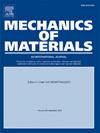A physically-based thermo-viscoelastic constitutive model of phantom and entangled networks in amorphous shape memory polymers
IF 3.4
3区 材料科学
Q2 MATERIALS SCIENCE, MULTIDISCIPLINARY
引用次数: 0
Abstract
Amorphous shape memory polymers (SMPs) are one of the most prominent smart and intelligent materials, whose constitutive models play important roles for their engineering designs and applications. Over the past decades, various thermo-viscoelastic constitutive models have been developed to simulate their shape memory behaviors, but these models are mostly phenomenological and often unable to explain the underlying mechanisms of their viscoelasticity and shape memory effects. Herein we propose a physically-based thermo-viscoelastic constitutive model to describe SMPs’ shape memory behaviors. We propose that the SMPs are composed of both hard and soft phase chains. The hard phase chains form a backbone network showing strong elastic responses, which can be modeled with a phantom network model. Whereas the soft phase chains form transient networks and entangled networks exhibiting viscoelastic behaviors, which can be explained using contour length relaxation and disentanglement relaxation phenomena. Time-temperature superposition principle is then incorporated to capture critical time-temperature dependence of the viscoelasticity and thermally induced shape memory effect. The proposed model has been implemented numerically and validated using shape memory experimental results at different recovery temperatures and heating rates, during the shape memory processes of amorphous SMPs. This work presents a good understanding of the viscoelasticity and shape memory effects of amorphous SMPs at the polymer chain level, and also provides an effective constitutive model for practical applications.
基于物理的非晶态形状记忆聚合物的幻影和纠缠网络的热粘弹性本构模型
非晶态形状记忆聚合物(SMPs)是目前最突出的智能材料之一,其本构模型对其工程设计和应用具有重要意义。在过去的几十年里,人们建立了各种热粘弹性本构模型来模拟它们的形状记忆行为,但这些模型大多是现象学的,往往无法解释它们的粘弹性和形状记忆效应的潜在机制。在此,我们提出了一个基于物理的热粘弹性本构模型来描述smp的形状记忆行为。我们提出SMPs由硬相链和软相链组成。硬相链形成一个具有强弹性响应的骨干网络,可以用虚网络模型来模拟。而软相链则形成瞬态网络和纠缠网络,表现出粘弹性行为,可以用轮廓长度弛豫和解纠缠弛豫现象来解释。然后采用时间-温度叠加原理捕捉粘弹性和热诱导形状记忆效应的临界时间-温度依赖性。在非晶smp的形状记忆过程中,采用不同恢复温度和加热速率下的形状记忆实验结果对该模型进行了数值实现和验证。本研究在聚合物链水平上对非晶SMPs的粘弹性和形状记忆效应有了很好的理解,并为实际应用提供了有效的本构模型。
本文章由计算机程序翻译,如有差异,请以英文原文为准。
求助全文
约1分钟内获得全文
求助全文
来源期刊

Mechanics of Materials
工程技术-材料科学:综合
CiteScore
7.60
自引率
5.10%
发文量
243
审稿时长
46 days
期刊介绍:
Mechanics of Materials is a forum for original scientific research on the flow, fracture, and general constitutive behavior of geophysical, geotechnical and technological materials, with balanced coverage of advanced technological and natural materials, with balanced coverage of theoretical, experimental, and field investigations. Of special concern are macroscopic predictions based on microscopic models, identification of microscopic structures from limited overall macroscopic data, experimental and field results that lead to fundamental understanding of the behavior of materials, and coordinated experimental and analytical investigations that culminate in theories with predictive quality.
 求助内容:
求助内容: 应助结果提醒方式:
应助结果提醒方式:


